- The following trial balance was extracted from the books of T. Onyancha a sole trader,
Additional information:
1. Stock as at 31 December 2003 was valued at...(Solved)
The following trial balance was extracted from the books of T. Onyancha a sole trader,

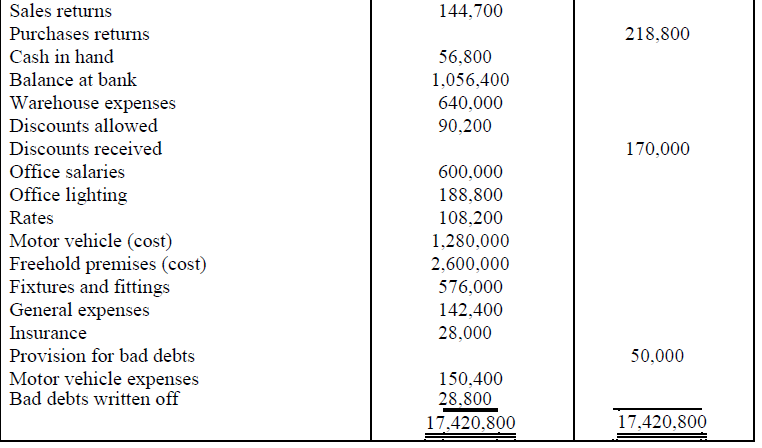 Additional information:
1. Stock as at 31 December 2003 was valued at Sh. 1,760,000
2. Depreciation on fixtures and fittings and the motor vehicle is to be provided at the rate of 5% and
10% per annum on cost respectively.
3. Rates prepaid as at 31 December 2003 amounted to Sh.25,600.
4. Unexpired insurance as at 31 December 2003 is to be made at 2 1/2 of the trade debtors,
Required:
a) Trading and profit and loss account for the year ended 31 December 2003.
b) Balances sheet as at 31 December 2003.
Additional information:
1. Stock as at 31 December 2003 was valued at Sh. 1,760,000
2. Depreciation on fixtures and fittings and the motor vehicle is to be provided at the rate of 5% and
10% per annum on cost respectively.
3. Rates prepaid as at 31 December 2003 amounted to Sh.25,600.
4. Unexpired insurance as at 31 December 2003 is to be made at 2 1/2 of the trade debtors,
Required:
a) Trading and profit and loss account for the year ended 31 December 2003.
b) Balances sheet as at 31 December 2003.
Date posted: May 16, 2019.
- The following trial balance was extracted from the books of Hari Singh as at 31December 2004:
Additional information:
1. Closing stock as at 31 December 2004 was...(Solved)
The following trial balance was extracted from the books of Hari Singh as at 31December 2004:
Sh. Sh
Drawings 1,600,000
Cash 676,000
Petty cash 100,000
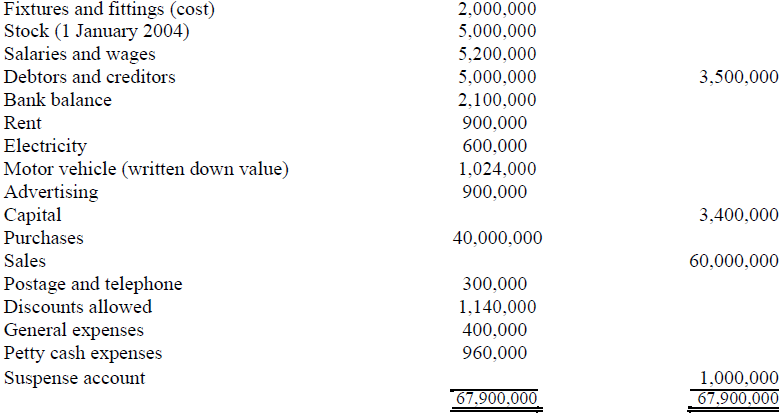 Additional information:
1. Closing stock as at 31 December 2004 was valued at Sh.7,500,000
2. Petty cash balance represents the month end imprest amount. As at 31 December 2004, the petty
cashier had vouchers amounting to Sh40,000 which had not been reimbursed by the main
cashier.
3. Discounts allowed amounting to Sh.100,000 had been posted to the debit of the debtors account.
4. Sales had been undercast by Sh400,000.
5. The motor vehicle, which had been purchased on 1 January 2002, was being depreciated at
20% per annum on the reducing balance basis. The original cost of the motor vehicle was
Sh.2,000,000. It has been decided that the motor vehicle be depreciated at 6% per annum on the
straight line basis and to make the change effective from the date of purchase.
6. Cash withdrawn from the bank for business use amounting to Sh400,000 had not been entered
in the bank column of the cash book.
7. No entry bas been made for stock valued at Sh1,000,000 taken by the proprietor for personal
use.
8. Telephone bills amounting to Sh.100,000 were unpaid as at 31 December 2004.
9. Advertising expenses include the cost of a sales campaign conducted during the year of
Sh.600,000. It is expected that the benefits of this campaign will be enjoyed or the next three
years.
10. Fixtures and fittings are to be depreciated at 20%. per annum on cost.
Required:
a) Trading, profit and loss account or the year ended 31 December 2004.
b) Balance sheet as at 31 December 2004.
Additional information:
1. Closing stock as at 31 December 2004 was valued at Sh.7,500,000
2. Petty cash balance represents the month end imprest amount. As at 31 December 2004, the petty
cashier had vouchers amounting to Sh40,000 which had not been reimbursed by the main
cashier.
3. Discounts allowed amounting to Sh.100,000 had been posted to the debit of the debtors account.
4. Sales had been undercast by Sh400,000.
5. The motor vehicle, which had been purchased on 1 January 2002, was being depreciated at
20% per annum on the reducing balance basis. The original cost of the motor vehicle was
Sh.2,000,000. It has been decided that the motor vehicle be depreciated at 6% per annum on the
straight line basis and to make the change effective from the date of purchase.
6. Cash withdrawn from the bank for business use amounting to Sh400,000 had not been entered
in the bank column of the cash book.
7. No entry bas been made for stock valued at Sh1,000,000 taken by the proprietor for personal
use.
8. Telephone bills amounting to Sh.100,000 were unpaid as at 31 December 2004.
9. Advertising expenses include the cost of a sales campaign conducted during the year of
Sh.600,000. It is expected that the benefits of this campaign will be enjoyed or the next three
years.
10. Fixtures and fittings are to be depreciated at 20%. per annum on cost.
Required:
a) Trading, profit and loss account or the year ended 31 December 2004.
b) Balance sheet as at 31 December 2004.
Date posted: May 16, 2019.
- The following trial balance was extracted from the books of Mohammed Kagame, a sole trader, as at
31 October 2004:
1. Stock in trade a s at...(Solved)
The following trial balance was extracted from the books of Mohammed Kagame, a sole trader, as at
31 October 2004:
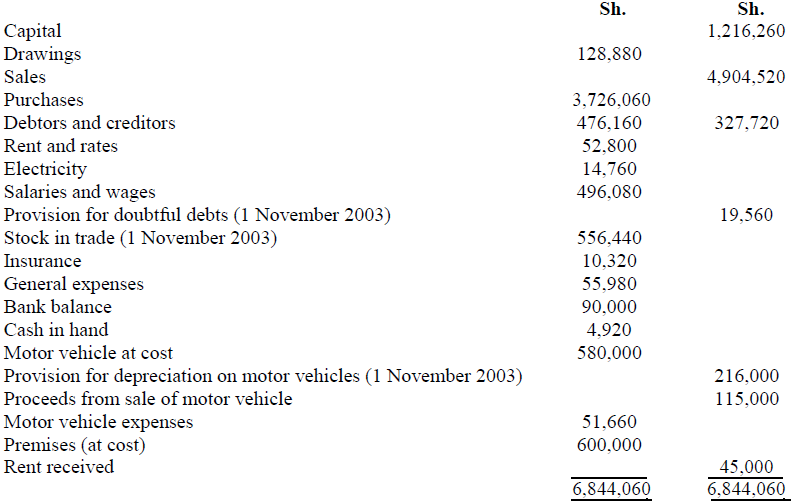 1. Stock in trade a s at 31 October 2004 was valued at Sh593,040.
2. Rates and insurance were prepaid to the extent ofSh.2,400 and Sh.2,820 respectively, as at 3 J
October 2004,
3. Electricity due as at 31 October 2004 amounted to Sh.6,000.
4. The provision for doubtful debts is to be adjusted to S% of the debtors remaining after taking into
account that Sh.20, 1 60 of the debtors were to be regarded as bad.
5. Rent receivable as at 31 October 2004 was Sh. 15,000
6. Depreciation has been and is to be charged on motor vehicles at the rate of 20% per annum on the
straight line basis. No depreciation is to be charged on premises.
7. In November 2003, a motor vehicle which had been purchased or Sh.160,000 on I November
2000, was sold for Sh.115,000. The only record of this disposal is the entry in the proceeds from
sale of motor vehicle account.
Required:
a) Trading and profit and loss account or the year ended 31 October 2004
b) Balance sheet as at 3 I October 2004.
1. Stock in trade a s at 31 October 2004 was valued at Sh593,040.
2. Rates and insurance were prepaid to the extent ofSh.2,400 and Sh.2,820 respectively, as at 3 J
October 2004,
3. Electricity due as at 31 October 2004 amounted to Sh.6,000.
4. The provision for doubtful debts is to be adjusted to S% of the debtors remaining after taking into
account that Sh.20, 1 60 of the debtors were to be regarded as bad.
5. Rent receivable as at 31 October 2004 was Sh. 15,000
6. Depreciation has been and is to be charged on motor vehicles at the rate of 20% per annum on the
straight line basis. No depreciation is to be charged on premises.
7. In November 2003, a motor vehicle which had been purchased or Sh.160,000 on I November
2000, was sold for Sh.115,000. The only record of this disposal is the entry in the proceeds from
sale of motor vehicle account.
Required:
a) Trading and profit and loss account or the year ended 31 October 2004
b) Balance sheet as at 3 I October 2004.
Date posted: May 16, 2019.
- The following balances were extracted from the books of Patel and Sons in respect of the year ended
31 December 2005:
1. Old furniture which stood in...(Solved)
The following balances were extracted from the books of Patel and Sons in respect of the year ended
31 December 2005:
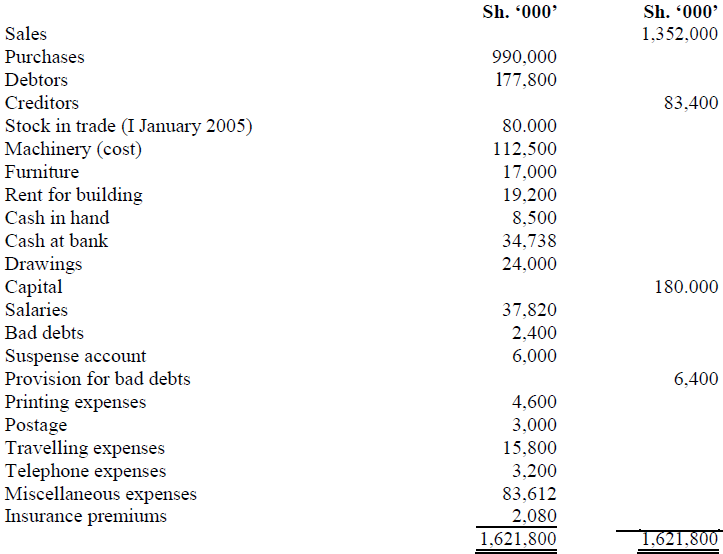 1. Old furniture which stood in the books (as at I January 2005) at Sh.2,400,000 was disposed of at
Sh.1,160,000 during the year in part exchange for new furniture costing Sh.2,080,000. A net
invoice of Sh.920,000 in respect of this transaction was erroneously passed through the Purchases
Day Book.
2. The suspense account represented money advanced to a sales team detailed to undertake a sales
campaign in the Rift Valley Province. On returning, the sales team disclosed that Sh.2,400,000
was used for travelling, Sh.1,000,000 for legal fees and Sh.1,800,000 for miscellaneous
expenses. The balance was yet to be refunded by 31 December 2005.
3. The business is conducted 10 a rented building and 50% or the building is used for
accommodation of the business owner's family.
4. Depreciation is to be provided on the straight line basis at 10%) per annum on machinery and 5%
per annum on furniture. Depreciation is to be applied for the whole year regardless of date of
purchase of the asset.
5. Total bad debts for the year amounted to Sh.4,000,000. Provision for doubtful debts is to be
maintained at 5% of the outstanding debtors
6. Closing stock amounted to Sh100,000,000
7. Insurance premiums cover the one year period ended 31 January 2006.
Required:
a) Trading and profit and loss account for the year ended 31 December 2005.
b) Balance sheet as at 31 December 2005
1. Old furniture which stood in the books (as at I January 2005) at Sh.2,400,000 was disposed of at
Sh.1,160,000 during the year in part exchange for new furniture costing Sh.2,080,000. A net
invoice of Sh.920,000 in respect of this transaction was erroneously passed through the Purchases
Day Book.
2. The suspense account represented money advanced to a sales team detailed to undertake a sales
campaign in the Rift Valley Province. On returning, the sales team disclosed that Sh.2,400,000
was used for travelling, Sh.1,000,000 for legal fees and Sh.1,800,000 for miscellaneous
expenses. The balance was yet to be refunded by 31 December 2005.
3. The business is conducted 10 a rented building and 50% or the building is used for
accommodation of the business owner's family.
4. Depreciation is to be provided on the straight line basis at 10%) per annum on machinery and 5%
per annum on furniture. Depreciation is to be applied for the whole year regardless of date of
purchase of the asset.
5. Total bad debts for the year amounted to Sh.4,000,000. Provision for doubtful debts is to be
maintained at 5% of the outstanding debtors
6. Closing stock amounted to Sh100,000,000
7. Insurance premiums cover the one year period ended 31 January 2006.
Required:
a) Trading and profit and loss account for the year ended 31 December 2005.
b) Balance sheet as at 31 December 2005
Date posted: May 16, 2019.
- The following balances were extracted from the books of Biashara Kubwa Enterprise, a wholesale
business, as at 31 October 2011:
...(Solved)
The following balances were extracted from the books of Biashara Kubwa Enterprise, a wholesale
business, as at 31 October 2011:
Sh.
Drawings 660,000
Trade receivables 990,000
Purchases 2,303,840
Sales returns 79,420
Capital 4,104,100
Trade payables 330,000
Sales 4,691,280
Purchase returns 120,340
Discount received 93,720
Provision for depreciation: Motor vehicle 176,000
Fixtures and fittings 63,800
Allowance for doubtful debts 44,000
15% bank loan 220,000
Salaries and wages 1,034,000
Discount allowed 54,560
Bank balance 568,260
Cash in hand 26,400
Electricity expenses 103,840
Rent and rates 54,560
Freehold premises (cost) 1,569,700
Fixtures and fittings (cost) 334,400
Motor vehicles (cost) 462,000
Stationery 34,320
Postage and telephone expenses 44,000
Insurance premiums 13,200
Bad debts written off 15,840
Motor vehicle expenses 84,920
Inventory (1November 2010) 1,393,480
Interest on bank loan 16,500
Additional information:
1. The following were the values provided on inventory as at 31 October 2011:
Replacement cost Sh. 1,036,400
Net realizable value Sh. 1,366,200
2. Sales include Sh. 300,000 worth of goods sold by Biashara Kubwa Enterprise agents', who are
allowed 15% commission on such sales. The transaction has not been recorded in the books.
3. Depreciation is to be provided as follows:
Fixtures and fittings 10% per annum on reducing balance basis. Motor vehicles
15% per annum on straight line basis
4. Annual insurance premium amounted to Sh. 12,000
5. As at 31 October 2011, there was a balance of Sh. 65,000 received from a customer in cash
6. Salaries and wages were in arrears of Sh. 35,000
7. The electricity bill for the month of October of Sh. 14,500 was received on 5 November 2011
8. Stationery stock amounted to Sh. 8,750
9. An allowance of 5% is to be maintained for doubtful debts
10.Goods worth Sh. 48,840 had been distributed to potential customers as free samples
Required:
(a) Income statement for the year ended 31 October 2011
(b) Statement of financial position as at 31 October 2011
Date posted: May 16, 2019.
- Lucy Wabetta operates a wholesale shop. The following information has been provided from her
business records:
1. All receipts are banked and all payments are made from...(Solved)
Lucy Wabetta operates a wholesale shop. The following information has been provided from her
business records:
1. All receipts are banked and all payments are made from the bank account. A summary of the bank
account for the year ended 30 September 2014 was as follows:
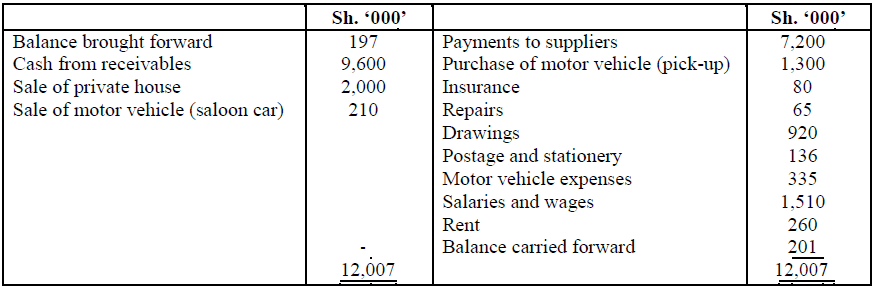 2. Discounts received amounted to Sh.110,000.
3. Assets and liabilities were as follows:
2. Discounts received amounted to Sh.110,000.
3. Assets and liabilities were as follows:
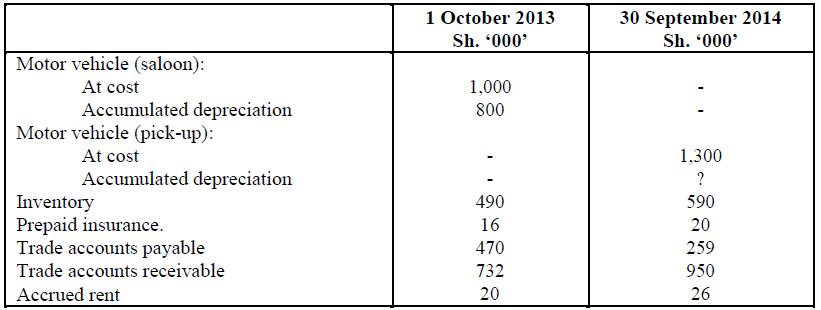 4. Included in the trade accounts receivable as at 30 September 2014 is Sh.30,000 that should be
written off.
5. Provide depreciation at the rate of 20% on cost of the motor vehicles held at the end of each
financial year. No depreciation is provided in the year of disposal.
6. Proceeds from the sale of the private house were capitalized.
Required:
(a) Income statement for the year ended 30 September 2014.
(b) Statement of financial position as at 30 September 2014.
4. Included in the trade accounts receivable as at 30 September 2014 is Sh.30,000 that should be
written off.
5. Provide depreciation at the rate of 20% on cost of the motor vehicles held at the end of each
financial year. No depreciation is provided in the year of disposal.
6. Proceeds from the sale of the private house were capitalized.
Required:
(a) Income statement for the year ended 30 September 2014.
(b) Statement of financial position as at 30 September 2014.
Date posted: May 16, 2019.
- On 31 December 2001 an inexperienced book-keeper working for Wanji, a sole trader, extracted a
trial balance. Due to errors committed by the book-keeper, the trial...(Solved)
On 31 December 2001 an inexperienced book-keeper working for Wanji, a sole trader, extracted a
trial balance. Due to errors committed by the book-keeper, the trial balance failed to balance by
Sh.369.400. He placed the difference in a suspense account as shown below:
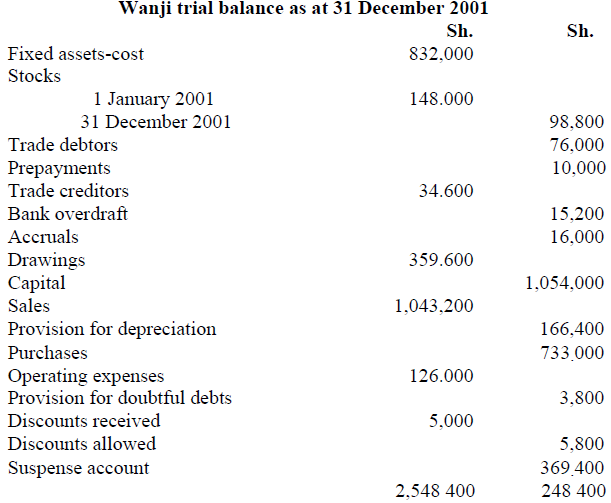 Investigations carried out after preparing the above trial balance detected the following errors:
1. The total of the sales day book for December 2001 was overcast by Sh.25,700.
2. On 2 July 2001 the business purchased office equipment for Sh.40.000. These were debited to
purchases account.
3. Depreciation on the equipment is at the rate of 10% per annum on cost and based on the period
(months) of usage in the year.
4. A payment to a creditor by cheque of Sh.8.500 was erroneously credited to the creditor's account.
5. A payment of Sh.4.500 for telephone expenses was debited to telephone account as Sh.5.400.
6. An amount of Sh.15.000 received from a debtor was not posted to the debtor's account
from the cash book.
7. An amount of discounts received of Sh.2.500 was debited to discounts allowed account.
8. Purchases day book for October 2001 was undercast by Sh.28,000.
9. Assume the business had reported a net profit of Sh.85,800 before adjusting for the above errors.
Required:
(a) The adjusted trial balance and the correct balance of the suspense account
(b) Journal entries to correct the errors (Narrations not required)
(c) Suspense account starting with the balance determined in the adjusted trial balance in (a) above.
(d) The adjusted net profit for the year.
Investigations carried out after preparing the above trial balance detected the following errors:
1. The total of the sales day book for December 2001 was overcast by Sh.25,700.
2. On 2 July 2001 the business purchased office equipment for Sh.40.000. These were debited to
purchases account.
3. Depreciation on the equipment is at the rate of 10% per annum on cost and based on the period
(months) of usage in the year.
4. A payment to a creditor by cheque of Sh.8.500 was erroneously credited to the creditor's account.
5. A payment of Sh.4.500 for telephone expenses was debited to telephone account as Sh.5.400.
6. An amount of Sh.15.000 received from a debtor was not posted to the debtor's account
from the cash book.
7. An amount of discounts received of Sh.2.500 was debited to discounts allowed account.
8. Purchases day book for October 2001 was undercast by Sh.28,000.
9. Assume the business had reported a net profit of Sh.85,800 before adjusting for the above errors.
Required:
(a) The adjusted trial balance and the correct balance of the suspense account
(b) Journal entries to correct the errors (Narrations not required)
(c) Suspense account starting with the balance determined in the adjusted trial balance in (a) above.
(d) The adjusted net profit for the year.
Date posted: May 16, 2019.
- Ali Osman is a sole trader who operates a retail business. His balance sheet as at 30 April 2004 was as
follows:
Although the trial balance did...(Solved)
Ali Osman is a sole trader who operates a retail business. His balance sheet as at 30 April 2004 was as
follows:
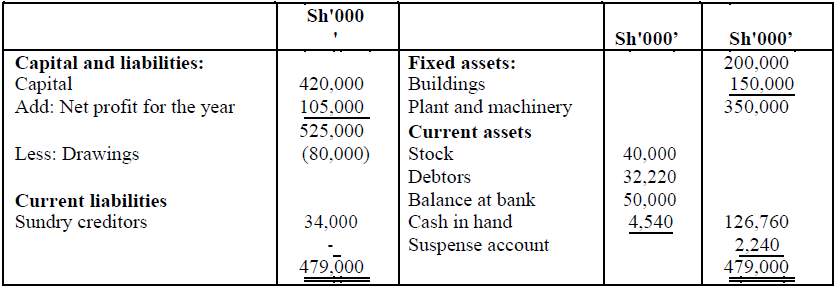 Although the trial balance did not agree, the above balance sheet was prepared and a suspense account
opened to which the difference was posted. At a later date, an inspection of the books revealed the
following:
1. The salaries day book had been overcast by Sh.3,000,000.
1. A payment of Sh. 1,560,000 received from a debtor had been recorded in the cashbook but had
not been posted to the personal account.
2. A discount received 0 Sh.150,000 had been posted to the wrong side of the personal account.
3. The stock book had been undercast by Sh.! 0,000,000 as at 30 April 2004.
4. Bank charges of Sh.850,000 had not been entered into the books.
5. A cash balance of Sh.500,000 had not been included in the trial balance.
6. An invoice for Sh.850,000 for private work commissioned by Ali Osman had been paid by the
business and posted to sundry expenses account.
Required:
a) Suspense account to clear the difference.
b) Statement showing the correct net profit or the year ended 30 April 2004
Although the trial balance did not agree, the above balance sheet was prepared and a suspense account
opened to which the difference was posted. At a later date, an inspection of the books revealed the
following:
1. The salaries day book had been overcast by Sh.3,000,000.
1. A payment of Sh. 1,560,000 received from a debtor had been recorded in the cashbook but had
not been posted to the personal account.
2. A discount received 0 Sh.150,000 had been posted to the wrong side of the personal account.
3. The stock book had been undercast by Sh.! 0,000,000 as at 30 April 2004.
4. Bank charges of Sh.850,000 had not been entered into the books.
5. A cash balance of Sh.500,000 had not been included in the trial balance.
6. An invoice for Sh.850,000 for private work commissioned by Ali Osman had been paid by the
business and posted to sundry expenses account.
Required:
a) Suspense account to clear the difference.
b) Statement showing the correct net profit or the year ended 30 April 2004
Date posted: May 16, 2019.
- a) Briefly explain the following:
i) Error of principle.
ii) Error of commission
b) Joshua Mwalo operates a small hardware shop. He extracts trial balance at the end...(Solved)
a) Briefly explain the following:
i) Error of principle.
ii) Error of commission
b) Joshua Mwalo operates a small hardware shop. He extracts trial balance at the end of every
month. The trial balance extracted as at 30 April 2005 did not balance, the credits exceeding
the debits by Sh.184, 320. Upon further investigation, the following errors were discovered:
1) A balance of Sh.10,440 on a debtor's account had been omitted from the schedule of debtors,
the total which was entered as debtors in the trial balance.
2) The receipts side o f the cash book had been undercast by Sh.72,900.
3) A credit note for Sh.2l A80 received from a supplier had been posted to the wrong side of
his account.
4) A computer purchased or Sh.144,000 had been written off to general expenses.
5) A debtor whose past debts had been the subject of a provision, paid Sh.87,720 to clear his
account. His personal account had been credited but the cheque had not yet been recorded in
the cash book
6) An electricity bill amounting to Sh.8,240 which had not yet been accrued, was discovered in
a filing tray.
7) The totals in the sales day book had been carried forward as Sh.948,780 whereas the correct
amount was Sh.978,480.
Required:
i) Journal entries to correct the above errors.
ii) Suspense account to dear the difference between the totals of the debit and credit sides.
Date posted: May 16, 2019.
- a) Explain any four purposes of journal entries in the accounting process
b) Walter Muita, a sole trader, presented the following balance sheet of his business...(Solved)
a) Explain any four purposes of journal entries in the accounting process
b) Walter Muita, a sole trader, presented the following balance sheet of his business as at 30 June
2005. He asked you to investigate the causes of errors giving rise to the amount in the
suspense account:
 You subsequently discovered the following errors:
1. The purchases day book was undercast by Sh.4,000.
2. A telephone head costing Sh.3,000 was bought and the amount was debited to the repairs account.
3. The telephone head is to be depreciated at the rate of 15% per annum as pari of fixtures
and fittings.
4. An amount of Sh.2,000 was omitted from total debtors.
5. Returns outwards of Sh.500 were erroneously entered in the sales book.
6. A payment of Sh.1,250 to a creditor was correctly entered in the cash book but credited to his
account.
7. Goods valued at Sh.l 0,000 were taken by Walter Muita for his own use and no entry has
been made to this effect.
8. A bad debt of Sh 1,250 had been written off
9. A discount received of Sh4,500 had been correctly recorded in the cash book but had been posted
to the wrong side of the discount received account.
Required:
i) Show the necessary journal entries to correct the errors listed above.
ii) Prepare a statement of adjusted profit (or loss) for the year ended 30 June 2005.
iii) Prepare the corrected balance sheet as at 30 June 2005.
You subsequently discovered the following errors:
1. The purchases day book was undercast by Sh.4,000.
2. A telephone head costing Sh.3,000 was bought and the amount was debited to the repairs account.
3. The telephone head is to be depreciated at the rate of 15% per annum as pari of fixtures
and fittings.
4. An amount of Sh.2,000 was omitted from total debtors.
5. Returns outwards of Sh.500 were erroneously entered in the sales book.
6. A payment of Sh.1,250 to a creditor was correctly entered in the cash book but credited to his
account.
7. Goods valued at Sh.l 0,000 were taken by Walter Muita for his own use and no entry has
been made to this effect.
8. A bad debt of Sh 1,250 had been written off
9. A discount received of Sh4,500 had been correctly recorded in the cash book but had been posted
to the wrong side of the discount received account.
Required:
i) Show the necessary journal entries to correct the errors listed above.
ii) Prepare a statement of adjusted profit (or loss) for the year ended 30 June 2005.
iii) Prepare the corrected balance sheet as at 30 June 2005.
Date posted: May 16, 2019.
- (a) Briefly explain the following types of errors:
i. Error of commission
ii. Error of principle
iii. Complete reversal of entries
iv. Compensating errors
(b) The trial balance of Amanda...(Solved)
(a) Briefly explain the following types of errors:
i. Error of commission
ii. Error of principle
iii. Complete reversal of entries
iv. Compensating errors
(b) The trial balance of Amanda Ltd as at 30 April 2004 did not balance. On investigation, the
following errors were discovered:
1. A loan of Sh.2,000,000 from one of the directors has been correctly entered in the cashbook
but posted to the wrong side of the loan account.
2. The purchase of a motor vehicle on credit fro Sh.2,860,000 had been recorded by debiting the
supplier’s account and crediting the motor expenses account.
3. A cheque for Sh.80,000 from Ogola, a customer to whom goods are regularly supplied on
credit, was correctly entered in the cashbook but was posted to the credit of bad debts
recovered account in the mistaken belief that it was a receipt from Agola, a customer whose
debt had been written off three years earlier.
4. In reconciling the company’s cash book with the bank statement, it was found that bank
charges of Sh.38,000 had not been entered in the company’s records.
5. The totals of the cash discount columns in the cashbook for the month of April 2004 had not
been posted to the respective discount accounts.
The figures were:
Sh.
Discounts allowed 184,000
Discounts received 397,000
6. The company had purchased some plant on 1 March 2003 for Sh.1,600,000. The payment was
correctly entered in the cashbook but was debited to the plant repairs account. Depreciation on
such plant is provided for at the rate of 20% per annum on cost.
Required:
(i) Journal entries with narrations to correct the above errors.
(ii) Suspense accounts showing the original difference
Date posted: May 16, 2019.
- Ben Mogaka prepared the following draft balance sheet for BM Enterprises as at 31 December 2005:
Additional information:
On further investigation, the suspense account was discovered to...(Solved)
Ben Mogaka prepared the following draft balance sheet for BM Enterprises as at 31 December 2005:
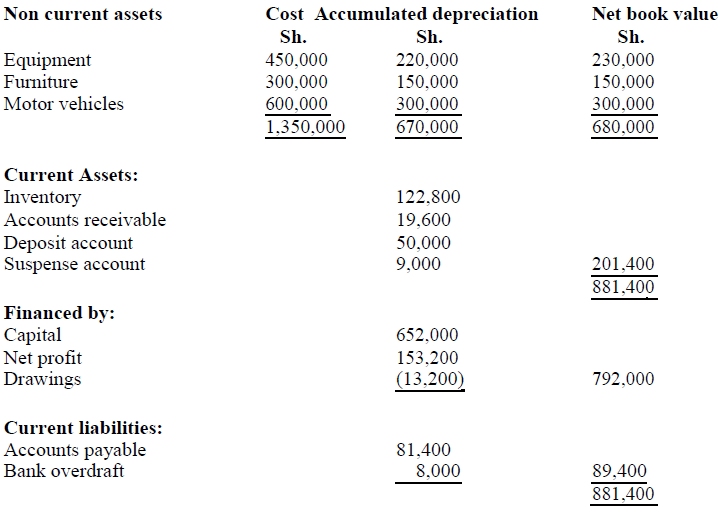 Additional information:
On further investigation, the suspense account was discovered to have resulted from the following
errors:
1. The sales of goods on credit to Alex Otis amounting to Sh.19,000had been recorded in the sales
journal as sh.9,000.
2. A receipt of Sh.20,000 from sale of an item of equipment had been credited to sales account. The
equipment was shown in the books of account at costs of account of Sh.90,000 and accumulated
depreciation of Sh.72,000.
3. A credit note from a supplier, Simon Masound for Sh.15,000 had been omitted from the books.
4. A bank overdraft for Sh.7,000 reflected in the cash book as at 31 December 2005 was omitted In
the trial balance.
5. A payment of Sh. 9,700 to Tom Wambugu, a creditor, was correctly entered in the cahs book but
posted to his personal account as Sh.7,900.
6. The debit side of rent expense account had been undercast by Sh.1,000.
7. A provision of Sh.2,000 for sundry expenses outstanding as at 31 December 2004 and debited to
sundry expenses at that dated had not been brought forward to the credit of the account in the
following period. No credit entry had been made in any other account in respect to this account in
respect to this item.
8. Discount received from the supplier of Sh.8,200 had been entered on the wrong side of purchases
ledger control account.
9. On 31 December, goods valued at Sh.9,600 (selling price) were returned by Jane Kerubo (a
debtor). No entry had been made in the books to reflect this transaction. These goods were not
included in the closing stock.
10. Discounts allowed were overcast by Sh.1,200.
Required:
(a) Journal entries to correct the above errors (Narration not required)
(b) Suspense account.
(c) Statement of corrected net profit for the year ended 31 December 2005
(d) Corrected balance sheet as 31 December 2005.
Additional information:
On further investigation, the suspense account was discovered to have resulted from the following
errors:
1. The sales of goods on credit to Alex Otis amounting to Sh.19,000had been recorded in the sales
journal as sh.9,000.
2. A receipt of Sh.20,000 from sale of an item of equipment had been credited to sales account. The
equipment was shown in the books of account at costs of account of Sh.90,000 and accumulated
depreciation of Sh.72,000.
3. A credit note from a supplier, Simon Masound for Sh.15,000 had been omitted from the books.
4. A bank overdraft for Sh.7,000 reflected in the cash book as at 31 December 2005 was omitted In
the trial balance.
5. A payment of Sh. 9,700 to Tom Wambugu, a creditor, was correctly entered in the cahs book but
posted to his personal account as Sh.7,900.
6. The debit side of rent expense account had been undercast by Sh.1,000.
7. A provision of Sh.2,000 for sundry expenses outstanding as at 31 December 2004 and debited to
sundry expenses at that dated had not been brought forward to the credit of the account in the
following period. No credit entry had been made in any other account in respect to this account in
respect to this item.
8. Discount received from the supplier of Sh.8,200 had been entered on the wrong side of purchases
ledger control account.
9. On 31 December, goods valued at Sh.9,600 (selling price) were returned by Jane Kerubo (a
debtor). No entry had been made in the books to reflect this transaction. These goods were not
included in the closing stock.
10. Discounts allowed were overcast by Sh.1,200.
Required:
(a) Journal entries to correct the above errors (Narration not required)
(b) Suspense account.
(c) Statement of corrected net profit for the year ended 31 December 2005
(d) Corrected balance sheet as 31 December 2005.
Date posted: May 16, 2019.
- After preparation of the trial balance or Bakari Brothers Enterprises as at 31 September 2005, the
firm’s accountant has been provided with the following additional information...(Solved)
After preparation of the trial balance or Bakari Brothers Enterprises as at 31 September 2005, the
firm’s accountant has been provided with the following additional information for the purpose of
preparation of the final accounts:
1. Due to an oversight, discount has been allowed to a credit customer on the gross invoiced
amount of Sh.80,000 at the rate 10%. The firm should have used a rate if 6%.
2. Electricity accrued amounts to Sh.36,710 while insurance premiums of Sh. 22,450 havebeen
prepaid.
3. In October 2005, the employees of the firm received a general salary increase, backdated to 1
July 2005. Amounts totalling Sh.126,550 in salary arrears are payable to former employees
who left shortly before the salary award was announced and who have not yet been traced. It
has been decided that the salary packets will be opened and the cash banked until the exemployees
are traced.
4. Wages due to casuals amounting to Sh. 464,120 for services rendered in the last week of
December 2005 were paid in January 2006 together with the salaries for the month of
December 2005 which amounted to Sh.301,700.
5. During the year, the exterior of the warehouse was repaired and repainted at a cost of
Sh.500,000. This amount was erroneously debited to office premises account. It is policy of
Bakari Brothers Enterprises to provide for depreciation on the closing balances of non-current
assets and this has already been done. The annual rate of depreciation on office premises is
2% calculated on the straight-line basis.
6. In December 2005 2005, Bakari Brothers Enterprises had bought goods on credit from CB
Ltd. for Sh. 452,100 and has also sold goods on credit to the same company for Sh.163,040.
These amounts were correctly posted to their respective accounts. However, these accounts
are to be offset as at 31 December 2005 and the remaining balance settled by cheque in
January 2006.
7. The provision for discounts allowed to debtors, which at present has a balance of Sh.229,530
needs to be reduced to Sh. 157,400.
8. Debts totaling Sh.64,800 are irrecoverable and should be written off. However, amount of
Sh.21,440 written off as a bad debt in the previous year has now been recovered in full but the
cheque in settlement has not been banked or posted in the accounts.
Required:
Journal entries, including narrations, necessary to record the above transactions in the books of Bakari
Bothers Enterprises.
Date posted: May 16, 2019.
- The trial balance extracted from the books of Benard Masita as at 30 September 2010 failed to
agree. The debit difference of Sh. 442,000 was posted...(Solved)
The trial balance extracted from the books of Benard Masita as at 30 September 2010 failed to
agree. The debit difference of Sh. 442,000 was posted to a suspense account. An income
statement was prepared which showed a gross profit and a net profit of Sh. 1,985,000 and
Sh.1,229,000 respectively. Upon investigations, the following errors were discovered:
1. A purchase of Sh 150,000 on credit was correctly posted to the suppliers account but was
completely omitted from the purchases day book.
2. Sales amounting to Sh. 250,000 to Samuel Njuguna were erroneously credited to his account.
The sales account had been correctly posted.
3. Salaries paid for the month of September 2010 amounting to Sh. 230,000 were recorded in
the salaries account as Sh 320,000.
4. Purchases of office stationery for Sh. 125,000 were erroneously debited to purchases account.
5. A payment of Sh.45,000 to Daniel Olunya, a creditor, was erroneously debited to the account of
Alois Olunya, another creditor.
6. An entry of Sh.21,000 for returns outwards was made in error in the sales day book instead of
in the purchases return day book.
7. A bad debt of Sh 22,500 is yet to be written off.
8. Goods valued at Sh220,000 were taken for personal use but no entry had been made in the
books.
9. A discount received of Sh.59,000 was correctly entered in the cashbook but posted to the
discounts allowed account.
Required:
i) A fully balanced suspense account.
ii) Statement of corrected gross profit.
iii) Statement of corrected net profit.
Date posted: May 16, 2019.
- Distinguish between "allowance for bad and doubtful debts" and "bad debts"(Solved)
Distinguish between "allowance for bad and doubtful debts" and "bad debts"
Date posted: May 16, 2019.
- Pata Transport Limited (PTL) was incorporated on 1 June 2006 and on the same day bought its first
lorry; KB099S for Sh. 9,000,000.
On 1 April 2007,...(Solved)
Pata Transport Limited (PTL) was incorporated on 1 June 2006 and on the same day bought its first
lorry; KB099S for Sh. 9,000,000.
On 1 April 2007, the company bought its second lorry KB 120T FOR Sh 12,000,000.
On 1 June 2008, the company bought a third lorry KB 340X for Sh. 6,000,000.
On 1 October 2008, lorry KB 099S was involved in an accident and was written off. The
insurance compensation paid to PTL by the insurers was Sh. 2,600,000.
On 31 December 2009,lorry KB 340X broke down and was traded in with a new lorry registration KB
419Y valued at Sh. 8,000,000.PTL; paid cash amounting to Sh. 5,400,000 for the lorry.
On 1 Apri12010, a van KB 890B was purchased for Sh 4,800,000.
Depreciation on motor vehicles is to be provided at the rate of 10% per annum on a straight line basis.
The policy of the company is to provide depreciation on a pro rata basis.
On 1 January 2009, the company decided to change its depreciation rate from 10% to 15% per annum.
The change was effected on motor vehicles that were in use retrospectively; that is from the year of
purchase. An adjusting entry was to be made in the accounts for the year ended 31 December 2009.
All lorries were comprehensively insured.
Assume the year end for PTL IS 31 December.
Required:
i) Motor vehicles account for the five years ended 31 December 2006,2007,2008,2009 and 2010.
ii) Provision for depreciation account for the same years stated in (b) (i) above
iii) Disposal of motor vehicles account
Date posted: May 16, 2019.
- Jabali Ltd. started its operations on 1 January 2008. The company acquired several items of plant
for its use. The amounts for the plant acquisitions, disposals...(Solved)
Jabali Ltd. started its operations on 1 January 2008. The company acquired several items of plant
for its use. The amounts for the plant acquisitions, disposals and depreciation far the years 2008, 2009
and 2010 are shown below.
The amounts for the year 2011 have not yet been computed.
Plant movement extracts for the years ended:
 Additional information:
1. Disposals took place at the beginning of the financial years as follows:
Date of disposal for the year ended Plant cost Sales
31 December proceeds
Sh'000' Sh'000'
Disposal of plant A 2010 15,000 8,000
Disposal of plant B 2011 30,000 21,000
2. Plant A and plant B were sold and replaced on the same date when plant C and plant D
were acquired. Plant D cost Sh.50 million while the value of plant C is to be derived.
3. Depreciation is charged at 20% on reducing balance.
Required:
(i) Extract of the plant movement schedule for the years ended 200S. 2009, 2010 and 2011
(ii) Profit or loss arising on disposal of plant A and plant B.
Additional information:
1. Disposals took place at the beginning of the financial years as follows:
Date of disposal for the year ended Plant cost Sales
31 December proceeds
Sh'000' Sh'000'
Disposal of plant A 2010 15,000 8,000
Disposal of plant B 2011 30,000 21,000
2. Plant A and plant B were sold and replaced on the same date when plant C and plant D
were acquired. Plant D cost Sh.50 million while the value of plant C is to be derived.
3. Depreciation is charged at 20% on reducing balance.
Required:
(i) Extract of the plant movement schedule for the years ended 200S. 2009, 2010 and 2011
(ii) Profit or loss arising on disposal of plant A and plant B.
Date posted: May 16, 2019.
- You have just been employed by Best Way Ltd as a trainee accountant. Your first exercise is to
check the transactions in the company’s cash book,...(Solved)
You have just been employed by Best Way Ltd as a trainee accountant. Your first exercise is to
check the transactions in the company’s cash book, check entries in the bank statement, update
the cash book and make any amendments as necessary after which you will prepare a bank
reconciliation statement at the end of the month.
The company’s cash book and bank statement for the month of March 2013 are provided below;-
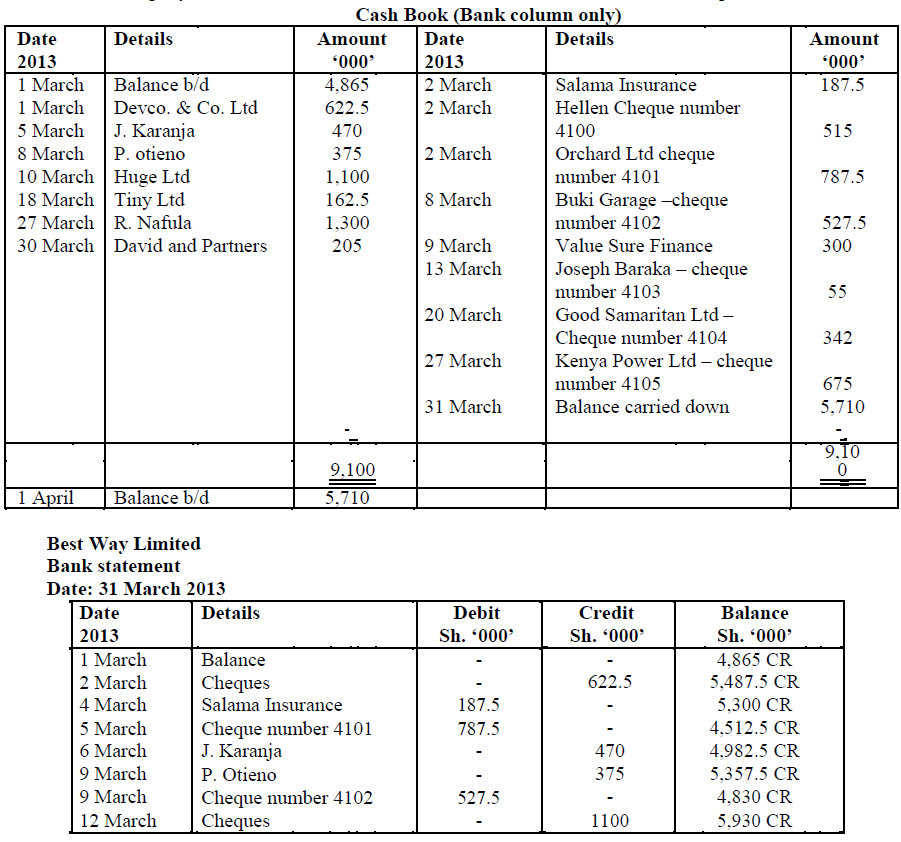
 Required;
A bank reconciliation statement as at 31 March 2013
Required;
A bank reconciliation statement as at 31 March 2013
Date posted: May 16, 2019.
- Explain the following methods of measurement of elements in financial statements:
i) Historical cost.
ii) Net realisable value.
iii) Present value.(Solved)
Explain the following methods of measurement of elements in financial statements:
i) Historical cost.
ii) Net realisable value.
iii) Present value.
Date posted: May 16, 2019.
- Distinguish between ‘purchased goodwill’ and ‘non-purchased goodwill’(Solved)
Distinguish between ‘purchased goodwill’ and ‘non-purchased goodwill’
Date posted: May 16, 2019.
- The following balances were extracted from the books of Furahia Enterprises for the month of
September 2013:
Sh.
Debit balance (1 September 2013): Sales ledger 14,280,000
Purchases ledger 1,920,000
Credit...(Solved)
The following balances were extracted from the books of Furahia Enterprises for the month of
September 2013:
Sh.
Debit balance (1 September 2013): Sales ledger 14,280,000
Purchases ledger 1,920,000
Credit balance (1 September 2013): Sales ledger 1,680,000
Purchases ledger 6,720,000
Credit notes received from suppliers 1,860,000
Debt collection expenses 480,000
Interest charged on customers' overdue accounts 384,000
Customers dishonoured cheques 1,260,000
Bad debts written off 720,000
Receipts from customers 1,280,000
Interest charged by creditors on overdue accounts^ 588,000
Payment to creditors 7,680,000
Contra settlements 390,000
Credit notes issued to customers 270,000
Credit sales 17,340,000
Cash sales 3,240,000
Cash purchases 2,160,000
Credit purchases 7,440,000
Discounts, allowed 1,080,000
Discounts received 690,000
Balances as at 30 September 2013:
Sales ledger (credit) 1,110,000
Purchases ledger (debit) 1,050,000
Required;
i) Sales ledger control account for the month ended 30 September 2013.
ii) Purchases ledger control account for the month ended 30 September
Date posted: May 16, 2019.
- The property, plant and equipment balances of Matatizo Ltd. comprised the following as at 1
January 2013:
The company uses the straight line method of depreciation on...(Solved)
The property, plant and equipment balances of Matatizo Ltd. comprised the following as at 1
January 2013:
 The company uses the straight line method of depreciation on assets as follows:
• 10% per annum for plant and machinery.
• 20% per annum for motor vehicles.
Additional information:
1. It is the company's policy to make a depreciation charge proportionate to the period of usage of the
asset.
2. An item of machinery bought on 1 July 2009 for Sh.10,080.000 was sold on 1 April 2013
at Sh.6,000,000.
3. From the year ended 31 December 2013, the management of the company decided to charge
depreciation on buildings at a rate of 2.5% per annum. The buildings were all completed on 1 July
2009.
4. On 1 January 2013, a vehicle purchased on 1 May 2010 for Sh.12,600,000 was traded in at a value
of Sh.7,320,000 in part exchange for a new vehicle costing Sh.18,000,000.
5. Included in machinery is an old machine which originally cost Sh.13, 500,000 and which was
already fully depreciated and not expected to yield any material amount on either use or resale.
6. On 30 June 2013, a machine costing Sh.13, 500,000 was purchased from a vendor who had used it
for three years. The vendor had bought the machine at Sh.18,000,000. Another machine costing
Sh.10,500,000 was purchased on 1 August 2013.
Required:
A schedule showing the movement of property, plant and equipment for the year ended 31 December
2013.
The company uses the straight line method of depreciation on assets as follows:
• 10% per annum for plant and machinery.
• 20% per annum for motor vehicles.
Additional information:
1. It is the company's policy to make a depreciation charge proportionate to the period of usage of the
asset.
2. An item of machinery bought on 1 July 2009 for Sh.10,080.000 was sold on 1 April 2013
at Sh.6,000,000.
3. From the year ended 31 December 2013, the management of the company decided to charge
depreciation on buildings at a rate of 2.5% per annum. The buildings were all completed on 1 July
2009.
4. On 1 January 2013, a vehicle purchased on 1 May 2010 for Sh.12,600,000 was traded in at a value
of Sh.7,320,000 in part exchange for a new vehicle costing Sh.18,000,000.
5. Included in machinery is an old machine which originally cost Sh.13, 500,000 and which was
already fully depreciated and not expected to yield any material amount on either use or resale.
6. On 30 June 2013, a machine costing Sh.13, 500,000 was purchased from a vendor who had used it
for three years. The vendor had bought the machine at Sh.18,000,000. Another machine costing
Sh.10,500,000 was purchased on 1 August 2013.
Required:
A schedule showing the movement of property, plant and equipment for the year ended 31 December
2013.
Date posted: May 16, 2019.
- The following is a summary of the cash book of Azimio Ltd. for the year ended 31 May 2014:
Subsequent investigations reveal that:
1. A page of...(Solved)
The following is a summary of the cash book of Azimio Ltd. for the year ended 31 May 2014:
 Subsequent investigations reveal that:
1. A page of the receipt side of the cash book has been under cast by Sh.200, 000.
2. The following transactions appearing on the bank statement have not yet been entered in the cash
book:
- Dividend received on a trade investment Sh.1, 147,000.
- Hire purchase repayments for 12 months at Sh.55, 000 per month.
- Interest for the half year to 30 November 2014 on a loan of Sh.20, 000,000 at 11 percent per
annum.
3. Bank charges of Sh. 143,000 shown on the bank statement have not yet been entered in the cash
book.
4. A cheque received from a customer for Sh.180, 000 was returned by the bank unpaid and no entry
has been made in the cash book for this transaction.
5. The company owes Sh.430, 000 for electricity consumed in the month of May 2014.
6. A cheque for Sh.82, 000 has been debited to the company's account in error by the bank.
7. A cheque drawn for Sh.98, 000 has been entered in the cash book as Sh.89, 000 and another
one-drawn for Sh.230, 000 has been entered as a receipt.
8. A transposition error occurred in the opening balance of the cash book. The opening
balance should have been brought down as Sh.850, 000 instead of Sh.805, 000.
9. Cheques paid to suppliers totalling Sh.630, 000 have not yet been presented at the bank, while
deposits totaling Sh.580, 000 made on 31 May 2014 have not yet been credited to the company's
account.
10. The balance as per the bank statement is an overdraft of Sh.870, 000.
Required:
(i) Adjusted cash book balance.
(ii) Bank reconciliation statement as at 31 May 2014.
Subsequent investigations reveal that:
1. A page of the receipt side of the cash book has been under cast by Sh.200, 000.
2. The following transactions appearing on the bank statement have not yet been entered in the cash
book:
- Dividend received on a trade investment Sh.1, 147,000.
- Hire purchase repayments for 12 months at Sh.55, 000 per month.
- Interest for the half year to 30 November 2014 on a loan of Sh.20, 000,000 at 11 percent per
annum.
3. Bank charges of Sh. 143,000 shown on the bank statement have not yet been entered in the cash
book.
4. A cheque received from a customer for Sh.180, 000 was returned by the bank unpaid and no entry
has been made in the cash book for this transaction.
5. The company owes Sh.430, 000 for electricity consumed in the month of May 2014.
6. A cheque for Sh.82, 000 has been debited to the company's account in error by the bank.
7. A cheque drawn for Sh.98, 000 has been entered in the cash book as Sh.89, 000 and another
one-drawn for Sh.230, 000 has been entered as a receipt.
8. A transposition error occurred in the opening balance of the cash book. The opening
balance should have been brought down as Sh.850, 000 instead of Sh.805, 000.
9. Cheques paid to suppliers totalling Sh.630, 000 have not yet been presented at the bank, while
deposits totaling Sh.580, 000 made on 31 May 2014 have not yet been credited to the company's
account.
10. The balance as per the bank statement is an overdraft of Sh.870, 000.
Required:
(i) Adjusted cash book balance.
(ii) Bank reconciliation statement as at 31 May 2014.
Date posted: May 16, 2019.
- Define a sequence control structure.(Solved)
Define a sequence control structure.
Date posted: May 15, 2019.
- Citing an example in each case, briefly explain four types of bookkeeping errors which are
not disclosed by a trial balance(Solved)
Citing an example in each case, briefly explain four types of bookkeeping errors which are
not disclosed by a trial balance
Date posted: May 15, 2019.
- Highlight six types of errors that could be reflected in a trial balance.(Solved)
Highlight six types of errors that could be reflected in a trial balance.
Date posted: May 15, 2019.
- Explain five challenges facing organizations that use computerized accounting software(Solved)
Explain five challenges facing organizations that use computerized accounting software
Date posted: May 15, 2019.
- Highlight six applications of accounting software packages.(Solved)
Highlight six applications of accounting software packages.
Date posted: May 15, 2019.
- Highlight four accounting tasks performed by accounting software packages(Solved)
Highlight four accounting tasks performed by accounting software packages
Date posted: May 15, 2019.
- Identify five benefits of customized accounting software.(Solved)
Identify five benefits of customized accounting software.
Date posted: May 15, 2019.